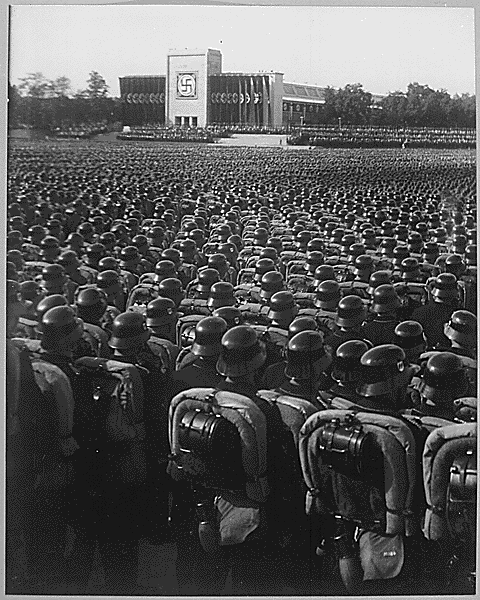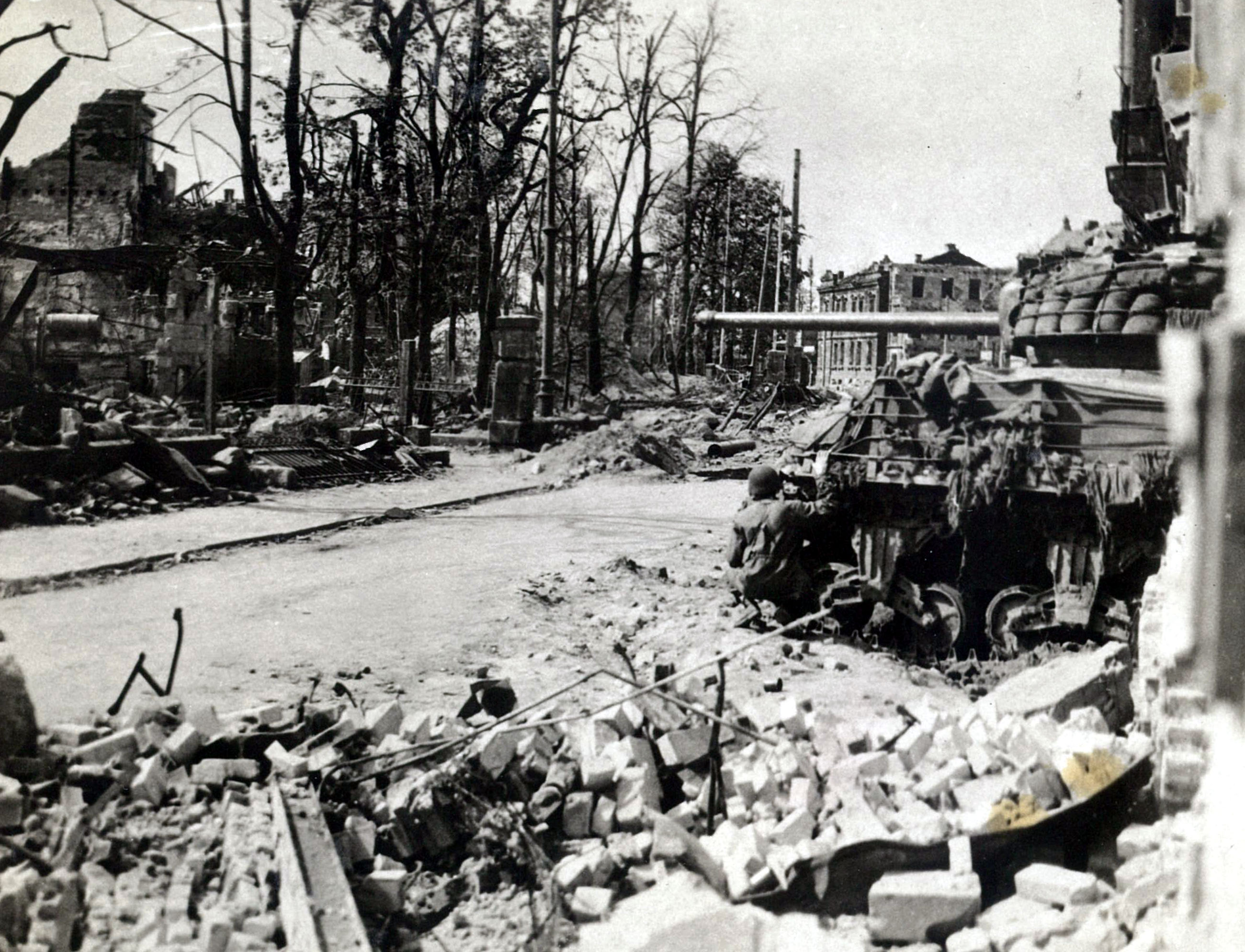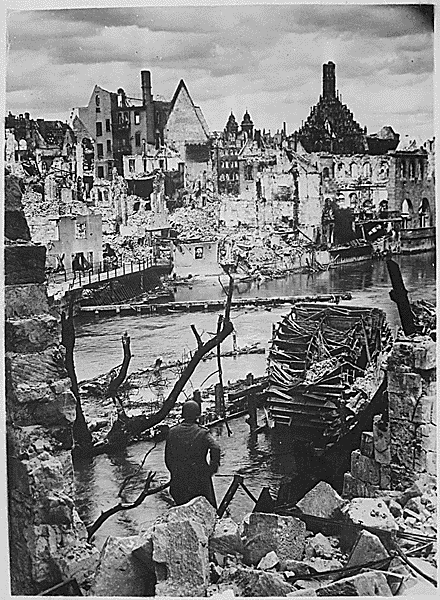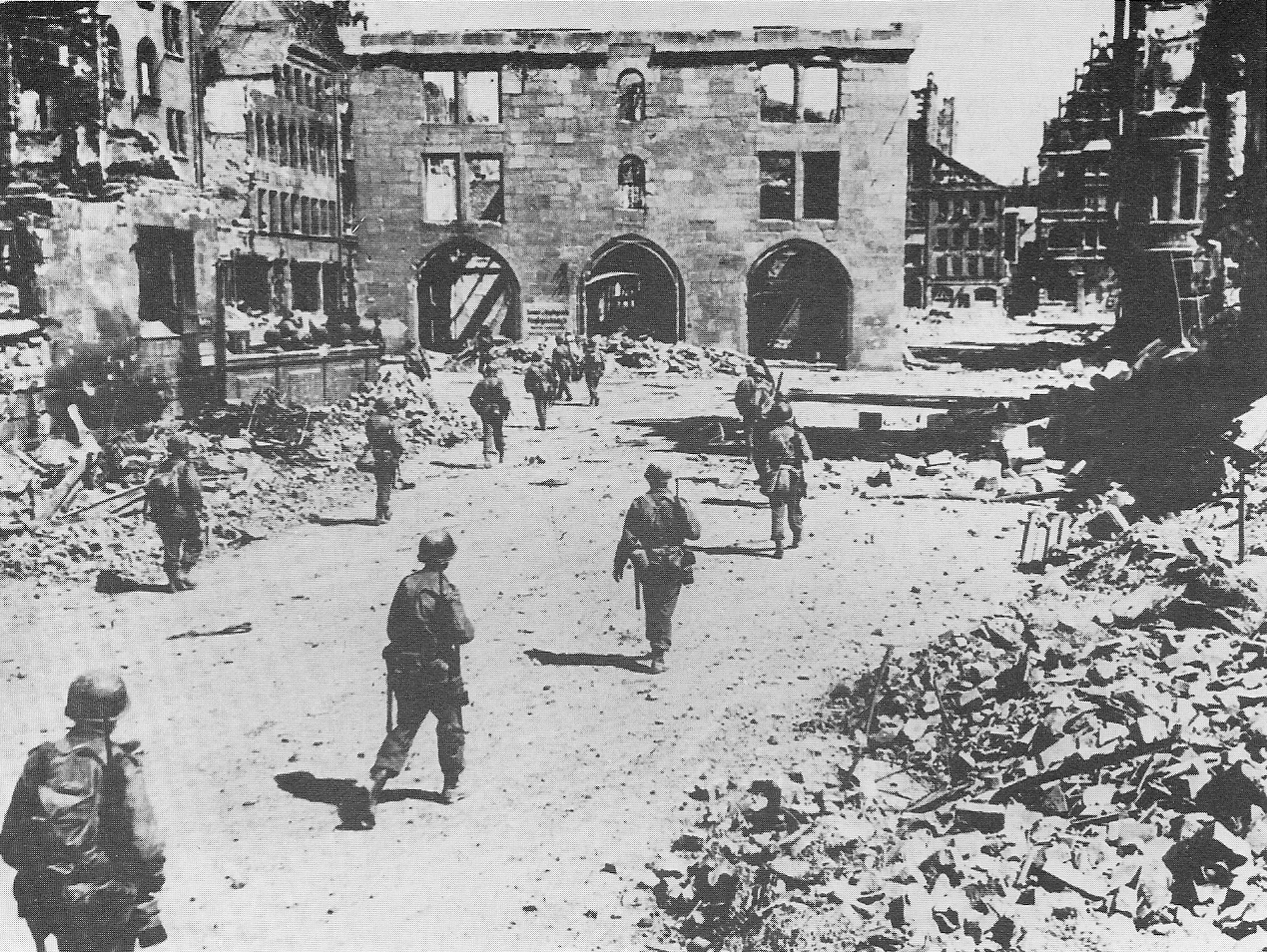The medieval city of Nuremberg, once the seat of power for German kings, became the scene of some of the bloodiest fighting of World War II in the month of April 1945. As American forces closed in to seize the former bastion of Adolf Hitler’s political power, fanatical Nazis mobilized for a battle of total annihilation and executed German civilians. The siege of Nuremberg would see American troops locked “in bitter fighting with the enemy, as Nürnberg reverberated with the sound of weapons of war and smoldered in its ruins,” according to U.S. Army 7th Infantry historian Nathan White in 1947.
Nuremberg was a fortress of National Socialism under Hitler’s regime. During the Middle Ages, the imperial city was a nexus of German might—a center of art, culture, industry, trade and centralized rule. After coming to power in 1933, Hitler and his followers capitalized on the city’s imperial past and associated Nuremberg with their ideals of empire and world conquest. Hitler’s political favor brought a boon of prosperity and prestige to the city, and Nazi interests were largely welcomed by residents.
The city became a hotbed of virulent racism and anti-Semitic violence. During the 1930s, Jewish residents were beaten and publicly humiliated by mobs, stripped of their property and executed. The city hosted extravagant public performances to boost racial pride—most notably the Nazi Party Rallies, which combined displays of military might with political speeches, sport performances, light shows and festivals. Nuremberg rallies seemed visually spectacular to the international public. Although members of the international media denounced Nazism, tourists from all over the world attended the rallies. The outbreak of World War II brought a halt to the opulent spectacles. However, during the war, the city of Nuremberg continued to host annual events commemorating Nazi ideology.

As Germany’s Third Reich collapsed under invading Allied forces in the spring of 1945, eyes on both sides zeroed in on Nuremberg. The Allies viewed the city as a high-value target; its capture was essential to break German morale. The Nazis were aware of Allied intentions to seize their imperial city—and had no intention of yielding it without a fight to the death.
By the time the battle-weary men of the U.S. 3rd Infantry Division rolled towards the city through the forested valleys of Bavaria, Heinrich Himmler had issued orders on April 3 that any male occupant of a residence who showed a white flag was to be shot immediately. Civilians in the vicinity of Nuremberg were given steel helmets, armbands, and firearms during the first week of April and ordered to resist invaders at all costs.
Civilians panicked. Radio propaganda broadcasted victory—but signs such as escaping POWs and German deserters caused doubt. Fear led to accidents with weapons—in Schwabach, a Volksturm militia man accidentally shot electrical wires while target practicing, and two boys, ages 12 and 14, were injured while attempting to prepare an explosive device. A mob of panicking townspeople raided a military grain silo—the violent brawl left a 16-year-old boy dead.
The Nazis commenced a reign of terror to suppress civilians as the Americans approached. A man in Brettheim who took away weapons from Hitler Youth was executed. Two local officials, including a mayor, were also killed for refusing to sign the death sentence. The three were hanged in the town cemetery and their bodies were left on display with an S.S. poster, which deemed them “cowardly, selfish, and disloyal traitors.”
Local commander Werner Lorleberg of Erlangen, a small city just north of Nuremberg, was murdered by an unknown assailant during his attempts to negotiate surrender with Americans. Civilians in Nuremberg who refused to take up arms were hanged. A 19-year-old Ansbach student, Robert Limpert, was denounced for sabotaging the Nazis and was hanged from the town hall gate as American troops encircled Nuremberg. Resistance was crushed.

Additionally, Hitler had already issued his “Nero Decree”— ordering German cities to self-destruct rather than fall into enemy hands. Nazi and S.S. officials in Nuremberg systematically prepared demolitions and rigged entire sections of the city to explode on command. However, the local radio personality, Arthur Schöddert, a popular organist and broadcaster known as “Uncle Baldrian”, charged with broadcasting the self-destruct signal—called “Code Puma”—failed to do so at the last minute. Instead Schöddert ended his final broadcast with the words: “I bid farewell to my listeners. Maybe one day we will hear each other again.”
American forces were met with furious opposition as they hemmed in around the outskirts of Nuremberg on April 16. The 3rd, 42nd and 45th U.S. Infantry divisions met with feverish violence from three German battle groups: S.S. troopers of Battle Group Dirnagel, Luftwaffe officers in Battle Group Rienow, and the 1st Battalion of the 38th S.S. Panzer Grenadier Regiment. Added to this, local residents shored up fierce resistance. They included the desperate Volkssturm militia and radicalized Hitler Youth, as well as an estimated 150 city firemen and 140 city police officers who fought as infantry.
Nuremberg became a hell of small arms fire, grenade explosions and tank blasts. Nearly all the windows of houses and apartment buildings contained nests of snipers; it took the American soldiers hours to clear city blocks. The Germans used bomb craters to create camouflaged dugouts.
Nuremberg’s Thon district presented some of the most gruesome urban combat. Civilians wielded Panzerfaust antitank grenade launchers, inflicting many casualties to American troops. The Germans also hid themselves in the debris, and as a result, American soldiers were ambushed from all sides. The stealth and vehemence of Nuremberg’s defenders required that American soldiers carefully clear every building during their advance. Room-to-room battles unfolded in some apartment buildings, as the army faced fanatical resistance. It took the U.S. infantry several long, hard hours to clear four apartment blocks. Tanks accompanied the soldiers forward.
“The Germans used every trick in the book to hold the city,” according to a history of the 3rd Infantry Division published by the U.S. Army in 1947. Aside from small arms fire, the U.S. infantrymen encountered mines and even German corpses rigged with booby traps.
“Panzerfausts were fired from top-story floors and rooftops at the American armor, but to the sorrow of the enemy, as the armor would wheel and practically blow them into the sky with rapid fire,” according to the U.S. Army.
The Germans continued to fight, however, using the medieval fortifications to launch attacks as the city disintegrated into a smoky inferno.
On April 19, the Americans closed in on the ancient citadel in the heart of Nuremberg—once the castle keep of the Holy Roman Emperor, it sported a massive stone wall and strongly built watchtowers.
One watchtower, the Laufer Tor, became a stronghold in a bizarre combination of modern combat and medieval siege warfare. U.S. Army 2nd Lt. Telesphor Tremblay and his men engaged in a pistol duel with no less than 125 German snipers holed up inside the tower. As in ancient times, the defenders used the tower as a high vantage point to stave off invaders from the keep’s walls. The siege only ended after the Americans introduced a barrage of bazookas to the fight, and the tower’s occupants surrendered.
The U.S. Army issued orders in German via loudspeakers to convince the remaining opposition to lay down their arms:
“Your city is completely surrounded and the old city has been entered in several places. People in the occupied part of the city are being treated humanely. Your unconditional surrender will be accepted under the following conditions: Raise white flags over the buildings and open all entrances to the inner city. Otherwise you will be destroyed. We will not wait, so act quickly.”
When no surrender was forthcoming, the soldiers brought an M-12 assault gun forward and began blasting the walls of the medieval fortress, firing direct hits at the keep wall and gates.
“Twenty rounds of the hard hitting big stuff were fired point-blank. But the old wall stood up under the terrific pounding with huge chips flying everywhere,” wrote White.
Germans at the St. Johannis gate surrendered, while American infantry breached a hole in the wall and allowed the remainder of the 3rd Division to enter.
On April 20, Hitler’s birthday, the struggle for Nuremberg came to an end. The day was initially overshadowed with grim expectations—the Americans anticipated attacks from diehard Nazis on the symbolic anniversary.
The German Werewolf terrorist organization was expected to strike; each member had pledged to kill an American soldier. And, true to predictions, Nazi forces in the old city launched a massive counterattack at 4 a.m. that day. The assault was so fierce that it nearly succeeded in repelling U.S. troops from their positions. The attackers used automatic weapons, grenades and Panzerfaust launchers.

However, they were soundly defeated by the determined valor of the American infantrymen, who rose to many daring acts of bravery during the bitter fight. Five members of the Third Infantry Division, from the 15th and 30th Regiments, would receive the Medal of Honor for the courage they displayed during the Battle of Nuremberg, including First Lieutenant Frank Burke, Captain Michael Daly and Private Joseph F. Merrell.
In a strange stroke of destiny, the city was ultimately taken on Hitler’s birthday. A group of tired yet victorious American soldiers stood on the main city square on a day that would normally have been celebrated with Nazi fanfare.
On April 22, American soldiers unfurled the Stars and Stripes over the Nazi Zeppelin Field, the scene of Hitler’s past glory. Lieutenant General Alexander M. Patch decorated the conquerors of Nuremberg for gallantry from Hitler’s former speaking platform. The men sang the popular anthem, “Dogface Soldier,” to celebrate their victory.
The gigantic stadium beyond them, where vast crowds had cheered and smiled for the Third Reich, was now a ghostly scene. Six huge bomb craters scarred the field once illuminated by Albert Speer’s “Cathedral of Light.” Swastika flags hung lifelessly from the 200 flagpoles lining the charred ruins. The Americans destroyed the last apparition of Nuremberg’s Nazi exaltation by detonating the stadium’s 20-foot-tall swastika with a 200-pound TNT charge.

